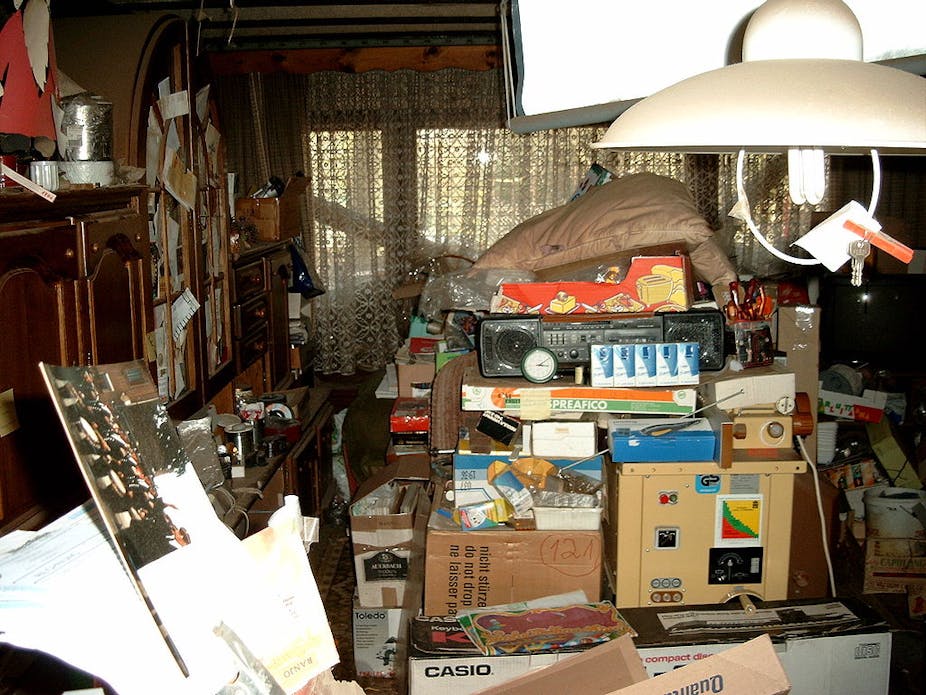MATTERS OF THE MIND – a series which examines the clinician’s bible for diagnosing mental disorders, the DSM, and the controversy surrounding the forthcoming fifth edition.
We’ve all got boxes of old letters, clothes and other keepsakes we’ve collected over our lifetime. Sometimes these boxes or shelves seem to take over spare rooms and garages. But while we might joke that we’re “a bit of a hoarder”, there’s a big difference between holding onto important mementos and compulsive hoarding.
Hoarding is the persistent difficulty discarding or parting with possessions and their ultimate stockpiling – regardless of their value. Possessions may include objects or animals, with the resulting clutter rendering living spaces unusable, unsafe or unhygienic.
Aside from problems discarding objects, people with hoarding difficulties report excessive acquisition, whether through compulsive buying or free procurement.
With prevalence estimates of around 2% to 5% of the population, somewhere between 400,000 and 1 million Australians are likely to have hoarding problems that cause them or others significant distress and conflict. Hoarding problems most commonly begin before early adulthood, although they most commonly present to services when affected individuals are much older.
Hoarding affects people from all social classes and educational backgrounds, though it commonly presents alongside depression, obsessive compulsive disorder (OCD), attention deficit disorder, other anxiety problems, compulsive buying, other impulse control problems, and other serious mental health problems.
The degree of self-awareness in individuals with hoarding problems varies, and is generally poorer than that in those with OCD.
Hoarding in the DSM-5
The American Psychiatric Association will likely recognise hoarding disorder as a separate diagnosis in its forthcoming fifth revision of the Diagnostic and Statistical Manual of Mental Disorders (DSM), placing hoarding within the obsessive-compulsive and related disorders (OCRD).
Current diagnostic manuals don’t account for compulsive hoarding or excessive acquisition as separate entities. In fact, the fourth edition of the DSM hardly mentions hoarding, except in the context of obsessive-compulsive personality disorder (OCPD), even though clinically it has been regarded as a subtype of OCD.
The DSM-5’s OCRD category brings together a range of complex disorders, such as anxiety, impulsive-compulsive and somatoform, a mental disorder that manifests in physical symptoms; inclusion of hoarding disorder within the OCRD diagnosis recognises its distinctiveness from related disorders.

Causes
Researchers have proposed a number of causes of excessive hoarding, including biases in how information is processed, insecurities in attachment patterns, problems in regulating emotions, and unhelpful thinking styles, particularly as they relate to objects and possessions. There is evidence implicating genetic factors, cognitive and brain functions.
Our own research has focused on thinking styles, early developmental influences, and insecure attachment patterns, adding to research findings linking hoarding to trauma. People with hoarding problems often report that amassing possessions helps them experience rewards and feel more secure, compensating for early emotional and material deprivation.
Treatment
Historically, hoarding has been considered resistant to treatment and had been dealt with through enforced clean outs – the style you see on reality television programs about hoarding. But these are generally ineffective and lead to unnecessary distress.
More recently, compulsive hoarding has been shown to be amenable to talk-based cognitive-behaviour therapy (CBT). CBT for hoarding involves helping affected people to:
- understand hoarding and thinking styles that maintain hoarding behaviours
- become more motivated to change unhelpful behaviours and thinking styles
- develop strategies that change unhelpful thinking
- build skills related to sorting, organising, and decision making
- increase control over impulses to acquire possessions and the inability to discard unnecessary clutter
- overcome anxiety and depression
- feel more confident within themselves and other people
- maintain their gains.
While there is consistent evidence that a specific CBT approach to the treatment of hoarding disorder can be effective, outcomes vary considerably. Such variance in outcomes is likely due to diversity in the disorder, although we have little understanding of what predicts outcomes.
While specialised CBT-based hoarding treatments are not yet generally available in Australia, we run a group and individual CBT program through the Swinburne University Psychology Clinic. Based on the approach of US researchers Randy Frost, Gail Steketee and David Tolin, our program has outcomes consistent with their published data.
We know that online treatments for related disorders, such as OCD, can be very effective, so we are currently in the process of developing an online version of our treatment. We are also developing alternative models of treatment, including groups moderated by previously affected individuals who have overcome their hoarding problems.
In the meantime, we’re working with government, local councils, and community organisations and services to develop preventative, early intervention, and support programs for people with hoarding problems.
Effective responses
The inclusion of hoarding in the DSM-5, the associated increased research and clinical interest, and media coverage of people with hoarding problems have been important determinants in activating governments and local councils to develop an integrated response to this complex problem.
Policies are being developed by various state governments that bring together social, health, mental health and aged services, police and fire brigade services, animal welfare, public and private housing agencies, local government and non-government organisations, and other bodies. Along with a well-trained and informed workforce, service coordination is essential to effective responses to those affected by hoarding.
This is the fifth part of our series Matters of the Mind. To read the other instalments, follow the links below:
Part one: Explainer: what is the DSM and how are mental disorders diagnosed?
Part two: Forget talking, just fill a script: how modern psychiatry lost its mind
Part three: Strange or just plain weird? Cultural variation in mental illness
Part four: Don’t pull your hair out over trichotillomania
Part six: Psychiatric labels and kids: benefits, side-effects and confusion
Part seven: Redefining autism in the DSM-5
Part eight: Depression, drugs and the DSM: a tale of self-interest and public outrage
Part nine: Why prolonged grief should be listed as a mental disorder)

